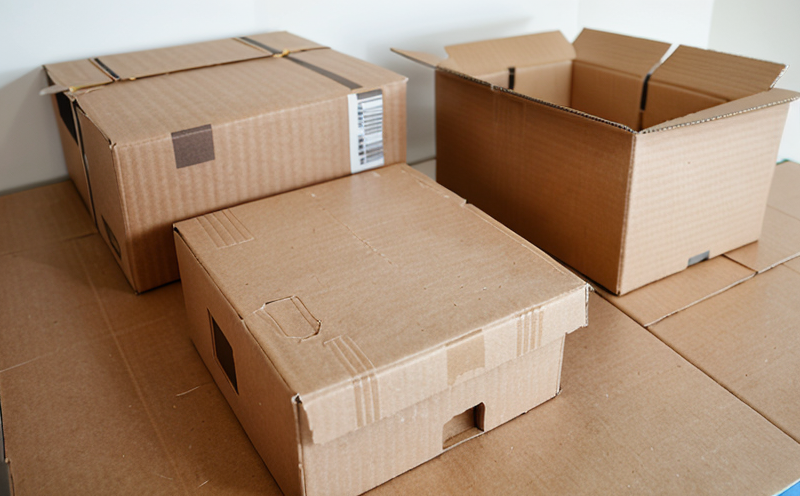ISO 534 Paper Thickness Testing
The ISO 534 paper thickness test is a fundamental procedure used to measure the average thickness of various types of papers and cardboards. This method ensures consistency in quality for packaging materials, which are critical components in ensuring product protection and sustainability. Quality managers, compliance officers, R&D engineers, and procurement teams rely on this test to ensure that the materials they use meet international standards.
The ISO 534 standard is widely recognized across industries as a reliable method of measuring paper thickness. This test is particularly important for sectors like consumer goods, pharmaceuticals, and food packaging where precise measurements are crucial to maintain product integrity and safety.
When performing the ISO 534 test, it's essential to follow strict procedures to ensure accurate results. The specimen must be carefully prepared according to the standard, which involves cutting a sample of the paper or cardboard into a specific shape. Once cut, the sample is placed between two parallel plates and compressed under controlled conditions until it breaks along its weakest point.
The thickness measurement is then taken from this break point. This method ensures that only the natural thickness of the material is measured without any external factors influencing the result. For precise testing, the laboratory uses high-quality instruments such as micrometers or digital calipers to ensure accuracy within a few hundredths of millimeters.
The results obtained from ISO 534 are critical for several reasons. First, they help in maintaining consistent quality across batches of paper and cardboard used in manufacturing processes. This is particularly important when dealing with large-scale production runs where even small variations can lead to significant discrepancies in product performance.
Secondly, the test results ensure compliance with international standards such as ISO 534:2018. Compliance with these standards is not only a regulatory requirement but also a mark of quality that consumers and business partners appreciate. By adhering to these standards, manufacturers can build trust with their customers and ensure that their products meet safety and performance expectations.
Lastly, the ISO 534 test plays a crucial role in sustainability initiatives. Understanding the exact thickness of paper and cardboard allows for more efficient use of resources during production. This reduces waste and helps minimize environmental impact, which is becoming increasingly important as companies focus on reducing their carbon footprint.
International Acceptance and Recognition
- The ISO 534 paper thickness test has been adopted by numerous countries around the world. It is widely recognized in industries that require precise measurements of paper and cardboard, including packaging, printing, and converting.
- In addition to its global acceptance, this standard is also used by regulatory bodies such as the European Union (EU) and the Food and Drug Administration (FDA) in the United States.
- The ISO 534 test is part of a broader suite of standards that ensure consistency in material specifications across different regions. This helps manufacturers comply with local regulations without compromising on quality.
- Many international organizations, including the International Organization for Standardization (ISO), have endorsed this method as a reliable way to measure paper thickness accurately.
Environmental and Sustainability Contributions
The ISO 534 test contributes significantly to environmental sustainability by promoting efficient use of resources. By ensuring that the correct amount of material is used in packaging, manufacturers can reduce waste and lower their carbon footprint. This aligns with broader corporate goals of becoming more environmentally responsible.
For instance, when determining the thickness of paper or cardboard for a particular application, ISO 534 helps companies avoid overuse of materials. Overuse not only increases production costs but also leads to unnecessary environmental degradation. By accurately measuring and specifying material thickness, businesses can adopt more sustainable practices without sacrificing product quality.
The test's role in sustainability extends beyond just reducing waste. It also supports the development of eco-friendly packaging solutions. For example, understanding the exact thickness requirements allows manufacturers to explore alternatives like recycled paper or bio-based materials that are more environmentally friendly.
Moreover, compliance with ISO 534 can be a key factor in certification programs aimed at promoting sustainable practices. This includes certifications from organizations such as FSC (Forest Stewardship Council) and Green Seal, which reward companies for their commitment to sustainability.
Use Cases and Application Examples
| Use Case | Description |
|---|---|
| Packaging Design | Determining the optimal thickness of paper or cardboard for packaging is crucial to ensure it can withstand the stresses and strains of distribution. ISO 534 helps designers select materials that provide adequate protection without being unnecessarily thick. |
| Quality Control | Regularly measuring the thickness of raw materials ensures consistency in production processes. This prevents defects that could lead to product recalls or customer dissatisfaction. |
| Packaging Compliance | Maintaining compliance with international standards is essential for exporting products. ISO 534 helps manufacturers ensure their packaging meets these requirements, thereby avoiding legal issues and maintaining a good reputation. |
| Recycling Programs | Understanding the thickness of paper or cardboard helps in designing effective recycling programs. Thinner materials are easier to recycle, reducing the amount of waste sent to landfills. |





